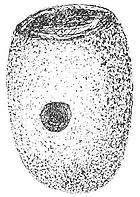ruthless socialism would be the adoption of very severe means for suppressing those who did not contribute their share of work. But in any case, as it seems, we never get away or break away from the inevitable fact. If individual ends could be suppressed, if every man worked for the good of society as energetically as for his own, we should still feel the absolute necessity of proportioning the whole body to the whole supplies obtainable from the planet, and to preserve the equilibrium of mankind relatively to the rest of Nature. That day is probably distant, but even upon that hypothesis the struggle for existence would still be with us, and there would be the same necessity for preserving the fittest and suppressing, as gently as might be, those who were unfit.—Contemporary Review.
| THE CALUMET IN THE CHAMPLAIN VALLEY. |
By Prof. G. H. PERKINS.
OF the many interesting objects which have been found in different localities in the United States none more fully illustrate the artistic skill and taste of the aborigines than do the stone pipes, and it is probably true that they represent the finest work in stone which the Indian was able to execute. In form, though not perhaps in material, the pipes exhibit greater variety and less conformity to conventional types than do other classes of prehistoric objects. No other specimens in our archaeological collections recall so completely the ceremonial usages  Fig. 1. of the Indians as do the pipes; no other objects occupied so important a place among the possessions of the tribe or the individual, as the student of Indian customs soon learns.
Fig. 1. of the Indians as do the pipes; no other objects occupied so important a place among the possessions of the tribe or the individual, as the student of Indian customs soon learns.
Pipes there may have been, and undoubtedly were, many of them of common mold, which were used and regarded very much as are modern pipes, simply as a means of social or personal enjoyment, and these may have been of earthenware, or even of wood or bone, more often than of stone; but the real calumet, the elaborately wrought ceremonial pipe, was a very different affair. With this were associated in the Indian mind the most solemn ceremonies, the most impressive experiences of life. Without the calumet no treaty could be ratified, no war declared, no important tribal or religious question settled. This single object combined in itself a dignity and an essential significance which can hardly be overestimated.
It is not strange, therefore, that the pipemaker should have
